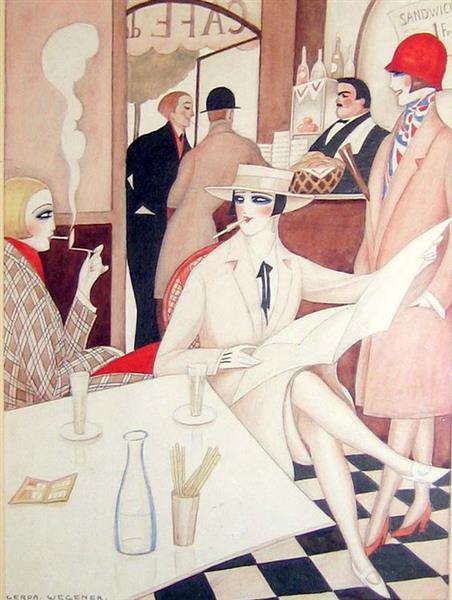Imagine yourself in one of the bustling cafes of 1920s Paris. You are a middle-class woman, hanging out with your friends. You might find yourself sitting at a small table, sipping on a cafe au lait. You are surrounded by other bohemian women. The sounds of jazz music and the chatter of customers are in the background. The aroma of coffee and cigarettes is filling the air.
As you look around, you might recognize several well-known authors, musicians, and painters are sitting, chatting, and debating in one of the corners. The 1920s in Paris were an exciting time. This is a period of great cultural and artistic experimentation, called the “Roaring Twenties” or the “Années folles” (Crazy Years). Hanging out in a cafe was a popular pastime among intellectual and creative people, as they gathered to discuss art, literature, philosophy, and politics.
This is a scene depicted in Gerda Wegener’s Au Café (c. 1925). Gerda Wegener is a Danish painter, known for her paintings that challenged gender and normative romantic relationships in her time.

Gerda Wegener
Date: c.1925
https://www.wikiart.org/en/gerda-wegener/au-cafe-1925
Wegener frequently depicts elegant and self-assured women in an Art Nouveau, Art Deco, or Renaissance-inspired style. Her subjects are usually captured engaging in creative activities like theater, writing, or dancing. Later on, the artist produces paintings that depict women expressing seductive power or indulging in sexual activities.

Gerda Wegener
Date: 1906
https://www.wikiart.org/en/gerda-wegener/portrait-of-ellen-von-kohl-1906
Portrait of Ellen Von Kohl (1906) is one of Wegener’s art nouveau portraits of a woman. Ellen von Kohl sits like a Renaissance lady with her face turned in the viewers. The face and the skin are in brighter tones compared to the dress, background, and hair. The subject looks like an elegant and mannered woman. Ellen von Kohl seems not to have obviously opened her eyes. She is in a partially trance state, between this reality and her mind. The sitter is depicted by the artist as looking at the audience rather than being observed from a masculine perspective.
Gerda Wegener
Date: 1923
https://www.wikiart.org/en/gerda-wegener/air-de-capri-1923
Air De Capri (1923) portrays two women playing guitar. This painting shows the freedom and creative atmosphere in which both women are engaging in a cultural activity. The subjects enjoyed playing guitar in a lovely setting surrounded by flowers and lemon trees.
You might know Gerda Wegener from a film The Danish Girl (2015). This film tells about how Gerda Wegener supported her partner, artist Einar Wegener, to do one of the first sex-change surgeries. Gerda Wegener often portrays Lili Elbe, who is her husband and dresses in women’s clothing. Later on, Einar comes to terms with his real gender identity and lives as a female. Lili Elbe (c. 1928) depicts a beautiful woman in chic attire. Her scarf matches with the geometric wall pattern. She is sitting in a cafe with a glass of wine in front of her. Gerda’s painting challenges gender boundaries at that time.
Gerda Wegener
Date: c.1928
https://www.wikiart.org/en/gerda-wegener/lili-elbe-1928
In Paris, Wegener started to push the boundaries of gender, producing more provocative paintings of women engaged in sexual activities and sensual poses.
Gerda Wegener
Date: c.1920
https://www.wikiart.org/en/gerda-wegener/peeping-tom-1920
Gerda Wegener is an inspirational artist who depicts women’s power and gender identity freedom. Her works can be seen on https://www.wikiart.org/en/gerda-wegener/
